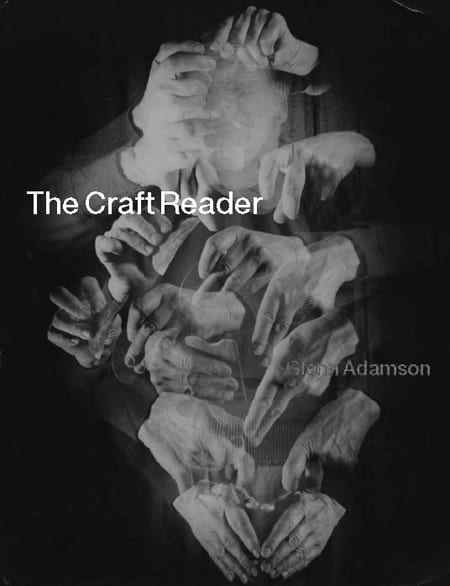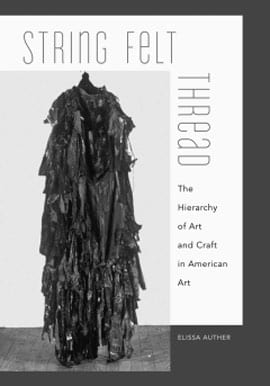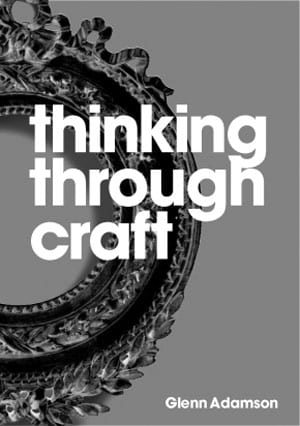 Elissa Auther. String, Felt, Thread: The Hierarchy of Art and Craft in American Art. Minneapolis: University of Minnesota Press, 2009. 248 pp., 83 color ills. $29.95, paper
Elissa Auther. String, Felt, Thread: The Hierarchy of Art and Craft in American Art. Minneapolis: University of Minnesota Press, 2009. 248 pp., 83 color ills. $29.95, paper
Glenn Adamson, ed. The Craft Reader. New York: Berg Publishers, 2009. 672 pp., 75 b/w ills. $39.95, paper
Glenn Adamson. Thinking through Craft. New York: Berg Publishers, 2007. 224 pp., 16 color ills., 44 b/w. $29.95, paper
By the time Rozsika Parker published Subversive Stitch: Embroidery and the Making of the Feminine in 1984, the following overtly feminist “stitched” works had already been made: Faith Wilding’s Womb Room, 1972; Harmony Hammond’s Presence V, also made in 1972; Faith Ringgold’s Zora and Fish, 1975; and Judy Chicago’s monumental Dinner Party, 1979—for which she employed extremely traditional fiber and ceramic craft techniques. Alongside these works and many others strategically soft and stitched, columns of political-art speech were woven into the discourse, most notably in the pages of the American magazine Heresies (issues number 3, Lesbian Art and Artists, 1977, and number 4, Women’s Traditional Arts—The Politics of Aesthetics, 1978).
Parker’s Subversive Stitch was the first and arguably the best researched distinctly art-historical work addressing the social utility of the fiber crafts in a feminist context. Using precedents from the Middle Ages to the twentieth century, she successfully codified what her American sisters had been overtly accessing in a contemporary forum—the fact that the domestic crafts identified with women’s work were at the very least undervalued as works of art, and were therefore appropriable for cultural and political use.
Parker took her interrogation one step further, however, through a close investigation of one traditional form in particular: embroidery. Within this narrow band, she traced the histories of various forms of stitching to demonstrate the employment of needlework in the “construction of femininity across classes.”1 In doing so, Parker identified the sexism inherent in a hierarchical system of classing methods and objects, while also pointing to an endless feedback loop of evaluation structured into this system, classing materials, processes, and forms, as well as the people who use them.
To be sure, this investigation of craft echoed much of what the American artists and writers had already unearthed. However, Parker’s contribution was different—as an art historian she could provide a grounded theory that pushed the social-justice issue beyond a subjective desire for inclusion. Parker made clear the differentiation “between the construction of femininity (as a course of socialization), lived femininity, the feminine ideal, and the feminine stereotype” as collapsed in the site of embroidery as not an art—but a craft. She did so by shedding light on the long history of taste guided by gender stereotypes (women who paint vs. men who paint) and, perhaps more radically, by pointing to the complexity of gendered facture/craft stereotypes (women/men who paint vs. women/men who stitch).
 Erected upon Old Mistresses: Women, Art, and Ideology (1981), her earlier book with Griselda Pollock, Subversive Stitch simultaneously acknowledged the importance of the maker’s sex while untying biological identity from the gendered construction and facture of objects. These ideas were echoed in the studio, where artists wrestled with notions of biology, authenticity, and originality in their work. For them, Parker’s text represented a significant shift in the conceptualizing of feminist strategies in art and the understanding of craft. For politicized artists with material interests, Parker’s work marked an important argument in the “constructed vs. essential” identity debate among feminists. By holding up this tangled web of associations, she allowed new circuits of causality and articulation.
Erected upon Old Mistresses: Women, Art, and Ideology (1981), her earlier book with Griselda Pollock, Subversive Stitch simultaneously acknowledged the importance of the maker’s sex while untying biological identity from the gendered construction and facture of objects. These ideas were echoed in the studio, where artists wrestled with notions of biology, authenticity, and originality in their work. For them, Parker’s text represented a significant shift in the conceptualizing of feminist strategies in art and the understanding of craft. For politicized artists with material interests, Parker’s work marked an important argument in the “constructed vs. essential” identity debate among feminists. By holding up this tangled web of associations, she allowed new circuits of causality and articulation.
Less than twenty years later, we would see a generation of artists—butch sissy-men and sissy butch-women—plug into these new circuits to re-deploy stitching, knitting, and crocheting directly into new varieties of ironic and earnest representations and cultural assertions. Among these artists we must include Mike Kelley in portions of his mid-1980s work, as well as Elaine Reichek, Oliver Herring, Beverly Semmes, and Charles LeDray, whose work in the mid-1990s provided a vital bridge to the now-ubiquitous use of soft and home craft strategies in art of every kind. For example, many of the artists included in Museum of Art and Design’s 2007 exhibition Radical Lace and Subversive Knitting, such as Elena Herzog, Cat Mazza, and Sabrina Gschwandtner, were members of this group. Gschwandtner stands out as a convergent force, gathering numerous artists together in her ’zine KnitKnit (2002–7), and the subsequent book KnitKnit: Profiles + Projects from Knitting’s New Wave, coauthored with Kiriko Shirobayashi (Stewart, Tabori and Chang, 2007).
The prominence of craft strategies in contemporary art practice has naturally led to a bounty of new books on the subject, including Elissa Auther’s String, Felt, Thread: The Hierarchy of Art and Craft in American Art. Auther’s serious historical scholarship chronicles the politics of an expanded family of fiber objects made in America since the 1960s. She concludes the book by examining the work of Reichek, Herring, and LeDray, along with other prominent artists such as Ghada Amer, Do Ho Suh, Ann Wilson, and Louise Bourgeois.
With an eye on the assimilation of work made of or from fibrous materials, Auther records the problematic history of the proposed hierarchy by swinging out from a feminist frame to the larger and occasionally more static dialectic of craft vs. art. She begins the story by marking juxtaposed inclusions into the exhibition and critical venues of high art. On one hand we have works of Fiber Arts that have grown out of the American craft movement; on the other, there are works that deploy craft materials and yet are positioned as Process Art. Auther precisely pairs the images of two works that appear somewhat similar at first glance: Alice Adams’s Construction, 1966, and Alan Saret’s Untitled, 1968. Thus, we are shown what we are also told in the details of the text, of the different critical agendas that held each work in place and apart, as craft and art respectively.
This foundational argument is made in great part by asserting that the material use and formal attributes of these two works could “conceivably lead to the conclusion that they were produced by the same hand “ (1). However compelling the contextual narrative, the argument is undone by closer inspection of the visuals. The photographic reproductions alone might attest to the intention and reception of the two objects—Saret’s is given a flatly lit, documentary look almost directly to the floor, while Adams’s work is framed at a lower angle, attempting to capture its profile, with the aid of careful lighting. And while Auther does note the differing degrees of formlessness, what is missed is exactly that line of distinction these two objects describe, one where the mess of process plainly overpowers a careful unraveling of form. What if the reception of Saret’s work had less do with material use (fiber) and more to do with his willingness to nearly eradicate form through actions completely unrelated to craft processes? Perhaps Auther’s argument is too neat to do justice to the complexity at hand.
 Using Bourgeois as a guide, Auther bookends a rich and complex account of the shifting critical receptions of fibrous works made in a variety of studio situations through the 1960s and 1970s. Hired in 1969 by the magazine Craft Horizons to review the Museum of Modern Art’s exhibition Wall Hangings, Bourgeois describes the work in the exhibition as something less than full-fledged art. Yet by the 1990s she herself is generating a plethora of stitched flatwork and sculpture to enthusiastic critical embrace. Between these illustrative moments, Auther situates the history of Fiber Arts in a greater context, redraws the relationships between and around the work of Eva Hesse and Robert Morris, and expands our knowledge of artists using craft methods and materials during the Feminist Art movement.
Using Bourgeois as a guide, Auther bookends a rich and complex account of the shifting critical receptions of fibrous works made in a variety of studio situations through the 1960s and 1970s. Hired in 1969 by the magazine Craft Horizons to review the Museum of Modern Art’s exhibition Wall Hangings, Bourgeois describes the work in the exhibition as something less than full-fledged art. Yet by the 1990s she herself is generating a plethora of stitched flatwork and sculpture to enthusiastic critical embrace. Between these illustrative moments, Auther situates the history of Fiber Arts in a greater context, redraws the relationships between and around the work of Eva Hesse and Robert Morris, and expands our knowledge of artists using craft methods and materials during the Feminist Art movement.
Although artists may preserve ideas in the course of making their work, codifying history still remains the sole province of art historians. Through this scholarship, we gain a collective understanding and knowledge of the artists whose groundbreaking work set the precedents for what has followed in contemporary art.
Among the beneficiaries of Auther’s scholarship is Harmony Hammond. The commanding resonance of Hammond’s early studio work in Lesbian Feminist art history and her participation in the 1970s dialogue about abstract painting have recently been documented in the exhibitions and catalogues WACK! Art and the Feminist Revolution and High Times, Hard Times: New York Painting, 1967–1975, respectively. Auther does the important work of positioning Hammond’s Floor Piece and Presence series as critical precedents concerning the use of craft. Similarly, the fullness of Auther’s insight into the painter Faith Ringgold’s use of craft materials, processes, and forms in defiance of the hegemony of a white, Western art-historical canon is impressive. In an ever-expanding global art context, this line of history is invaluable.
As a whole, String, Felt, Thread rests in great part on Parker’s Subversive Stitch and Parker and Pollock’s Old Mistresses. Auther also embraces ideas put forward in Glenn Adamson’s provocative 2007 book Thinking through Craft, applying his notion of craft’s “subordination and marginality as indispensible to the evolution of art” (xxix, String, Felt, Thread). With apt observations of the subordination of traditional craft origins—as practice and identity—Auther shows us the valuation system that dominated most of the twentieth century in America, demonstrating the hierarchy at every step.
As a result, the ongoing “struggle for legitimacy,” a concept stated early on in String, Felt, Thread, becomes a uniquely American story of social justice in an art context. In many respects, this is the best aspect of the book, shedding light on art that deserves more of it. However, in this same narrative struggle lurks an imperative to dismantle all hierarchies. And this sensibility seems to close down the potential for embracing differences we may have simply enjoyed from the start. This is surely the only constraint Auther’s theory suffers in service of history.
Consider an alternate narrative guide to the categories art and craft. put forward in Adamson’s Thinking through Craft. This story is more of a dance than a struggle. Adamson choreographs a new set of moves toward a more specific entanglement between art and craft. Rather than fixing an identity, Adamson takes a straightforward interest in thinking through new problems, named in each of the five chapters and offered to open up our understanding of craft. His approach is one that echoes the sometimes messy, sometimes meticulous work habits of the studio. It is enormously refreshing, as are his sites of investigation: Supplemental, Material, Skilled, Pastoral, and Amateur.
In each chapter he invites the reader into a way of thinking that is empowering in its fluid reconstruction of how we relate to art and craft via these “new” categories. Setting aside any overly essentialized notion of maker and made, we are challenged to match Adamson’s skillful attributions of culturally constructed features (of things, parts of things, processes, and behaviors) exactly where pathways of more nuanced understandings might open up. It is not that identity or facture no longer have a claim on the classing of art—but he rightly assumes that we are so much more sophisticated at using the politicized tropes of all crafts, that categorical distinctions between this and art no longer make sense.
Now add one more important book to the recent proliferation of compilations and theoretical texts on the subject: The Craft Reader, edited by Adamson. This substantive compilation was born, he says, of “seeds planted” while he participated in a graduate seminar led by Edward S. “Ned” Cooke, Jr., at Yale more than ten years ago. Adamson launches the reader in the wake of Thinking through Craft, and the two books work nicely together, even though it’s a thrill that the first book does not provide a perfect footing for the second, since the categories of thinking do not completely align book to book. In fact, Thinking through Craft feels more like a wondrous hole of ideas dug out as a groundbreaking preparation for the commencement of new structures.
Without doubt, The Craft Reader provides an ample first collection in the service of a theoretical architecture about “making things” by considering the specific intersection of modernity and craft. As in Thinking through Craft, Adamson uses industrial technologies and markets as the catalysts for our changing relationship to those elements we thus far have identified as craft. In doing so, his anthology takes on terms that exceed the narrow view of the art world, recalibrating what we might think are pertinent distinctions and methods of organizing. Applying frameworks used to discuss the making of all things, he addresses the subject in broad commercial terms for most of the book, devoting only one section to what in context seems to be a tiny American art vs. craft debate over the status of objects.
The anthology is divided into seven sections, reflecting an organizational strategy that interlaces historical precedents, areas of studio expertise, points of view, and theoretical reference points into a stable but pliable tool. Section 1, “How-To,” boldly asserts the seriousness of what might be an otherwise ironic gesture, embracing the overt physicality of learning how to make. What follows—including Michael Ettema’s nuanced view of craft’s role in furniture making of the late nineteenth century; all of Section 4, titled “The Persistence of Craft in the Age of Mass Production”; and much more—amplifies Adamson’s forthright disruption of the commonly held explanation of the modernism-craft juncture as that place where deskilling flourished as a result of industrialization, while the Arts and Crafts movement benevolently pushed back to keep traditional skills (and values) alive. In all, the value of Adamson’s work as both author and editor is the agility and confidence he draws on in applying significant political, historical, and aesthetic material to the topic of craft so to overwhelm finally the simplistic art-craft divide. This work allows us to consider the economic, social, and spiritual viability of craft anew: the parallel worlds of art and the artisanal, the use of historically established material hierarchies to gain new political ground, and the legacy of utopian idealism found in the Craftivists of the twenty-first century.
Last, but surely not least, Adamson makes sure that the considerable impact of the Bauhaus—as both pedagogy and design strategy—is present, but it is not the only force at play in shaping the makers’ relationships to modern industry. With the help of voices like Ettema’s, and perhaps most notably with the inclusion of Rafael Cardoso’s 2008 essay “Craft versus Design: Moving Beyond a Tired Dichotomy,” Adamson puts design in a new light. And while it may be consoling to be reminded that everyone has his or her own false dichotomies, the task at hand requires that all must be dismantled simultaneously. Somehow in this mix, the designed object comes into focus as a force capable of rupturing the old art-craft divide. It emerges as if a missing link, previously identified as either the disavowed, machine-made commodity, from a pure craft perspective, or the high-class, intellectually supercharged readymade in the palaces of high art. Now maybe another divide can be put to rest. Art and design have a renewed common core: craft.
Sheila Pepe is an artist and educator who lives and works in Brooklyn. She is represented by Sue Scott Gallery in New York and Carroll & Sons in Boston, and serves as the acting assistant dean of art and design at Pratt Institute. Her work includes a range of crafted objects, drawings, and installations that she has shown publicly since 1995. Additional work and a partial archive of her many temporary installations can be found at sheilapepe.com.
- Rozsika Parker, “The Creation of Femininity,” in The Subversive Stitch: Embroidery and the Making of the Feminine (New York: I. B. Tauris, 2010), 15. ↩
